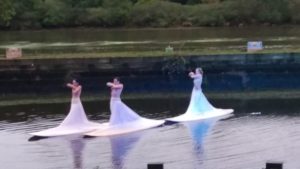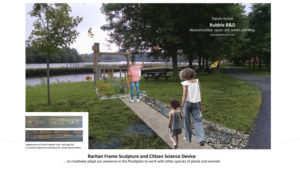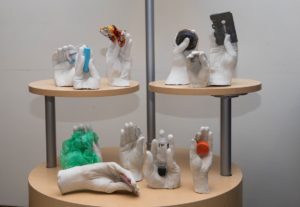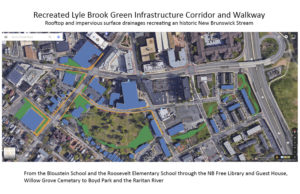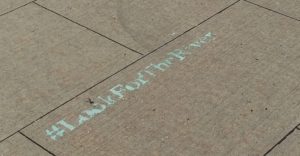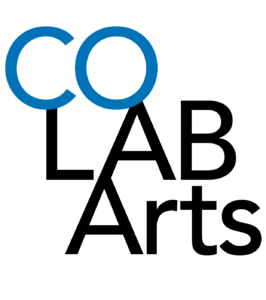# lookfortheriver
#lookfortheriver inspires care for neglected waterways in the context of climate change, intensified urban flooding, and sea level rise. It is a transformative climate justice campaign and social movement that empowers geographically and socio-economically vulnerable populations to value and restore freshwater ecosystems and the environment as community care and resilience. Working at multiple scales it involves local streamside actions of knowledge co-production, performances of climate change impacts and proposed solutions, art installations that pattern regional stewardship and adaptation, engagement with national circuits of knowledge and practice, and connection with global movements that embrace water as the lifeblood of our communities.
As a campaign #lookfortheriver transforms community-environment connectivity through knowledge co-production and the arts and cultivates cultures of on-going environmental stewardship.
As a social movement #lookfortheriver advances a cross-scales theory of landscape change and resilience.
At all scales work is conceived and articulated in non-economic terms of shared health, prosperity and well-being.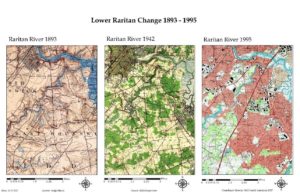
#lookfortheriver is how we remember forgotten landscapes.
We do this by observing water flows, by tracing land contours, and by re-discovering our buried streams.
THE NEED
Centuries of piping, culverting and development have hidden the vast majority of streams and rivers in our urban landscapes. The impact is devastating: communities are alienated from their waterways and historic ecologies, habitats are degraded, water quality is compromised, and stormwater runoff and flooding intensify. In the US and globally these impacts are most acutely felt in areas with low socioeconomic status and vulnerable populations. In the face of climate change and increased precipitation and runoff, these communities bear disproportionate risk and adaptive burden.
Although little is known about how people in flood prone areas perceive present and predicted changes, literature indicates that framing climate change as a global problem makes it abstract, compromising local actions to mitigate and adapt. We need culturally appropriate ways of relating to our waterways that make clear relationships between local land development approaches that “disappear” our streams and rivers and the risks communities face as a result. Our economic system, reinforced by politically-based land-use planning, does not prioritize the well-being of the environment or our most vulnerable populations. Just, equitable adaptation requires land use planning for healthy watershed ecologies, including relationship building around non-economic modes of valuing and caring for water, community and environment.
APPROACH
#lookfortheriver directly addresses the climate crisis and inequality through climate adaptation planning done in partnership with low socio-economic and vulnerable communities in geographic areas most at risk. It works through culturally appropriate projects co-produced and shared throughout these communities. Likewise, it works by revealing how local land use decisions and racially-based policies like red-lining result in disproportionate and unjust climate impact burdens.
In 2012, 1 billion gallons of sewage overflow discharged from a sewage treatment plant into the Raritan River, a result of Superstorm Sandy storm-surge flooding that inundated centralized treatment facilities. #lookfortheriver engages communities in deep understanding of hydrologic flows and local landscape restoration. Community-led analysis of ecosystem functions identifies how “urban metabolism” of sewage can be leveraged to generate energy, restore waterways, and lead to an inclusive clean economy. Community-led analysis reveals who profits and who loses in regions with consolidated sewage treatment systems. #lookfortheriver builds community support for distributed wastewater treatment systems that, unlike centralized systems, don’t risk catastrophic failure. Distributed wastewater treatment can provide “clean energy” by treating and recycling organic waste where it is produced, generating low cost energy for the local community.
#lookfortheriver advocates structural transformation across scales, and adopts a perspective that sees justice as including legal, constitutionally-based environmental rights. It empowers our communities beyond economic modes of valuing and caring for water, community and environment.
#lookfortheriver is rooted in an understanding that grassroots action linked across scales sustains and enriches local efforts. It is designed to operationalize strategies for how grassroots movements can leverage local knowledge and action to effect change in environmental policy across scales. In this it meets a need for new strategies of community engagement around climate change adaptation, and modeling of these strategies for community outreach professions.
#lookfortheriver grew out of the work of the non-profit Lower Raritan Watershed Partnership (LRWP), which was founded to address environmental threats in central New Jersey e.g. legacy industrial pollutants, development, flooding, non-point pollution and climate change. It is currently deployed on an ad hoc basis, as grant funds and donations allow.
TARGET AUDIENCES
Through #lookfortheriver and other outreach programs we train community members to recognize and document climate-related changes in our landscapes. This includes advancing community understanding of historic hydrology and mapping “hidden streams.“
#lookfortheriver augments current outreach in communities severely impacted by coastal and riverine flooding events. The outreach region includes significant Low and Moderate Income (LMI) and HUD LMI Block Group populations, and approximately 61% of the population are characterized as socially vulnerable (e.g., elderly; single parent households; adults, children and youth who are homeless or at risk of homelessness; people with disabilities or behavioral health needs).
The #lookfortheriver campaign involves local decision makers, civic groups, environmental educators and others in outreach about our hidden streams and why we must find them. It involves outreach with participants at fairs and school and community groups.
The #lookfortheriver movement engages national professional associations and global networks.
#lookfortheriver is how we celebrate our waterways.
We do this by bringing our communities together for play, exploration and stewardship.
coLAB Arts “Watershed Moment” 2016
PARTNERS
Collaboration drives this project. At the local level partners include coLAB Arts, Rutgers Cooperative Extension, Raíces Cultural Center, Lazos America Unida and many schools and government entities. We also partner with Middlesex County, and the New Jersey Council for the Humanities. (Click here to read a summary of how the arts engages in this space).
LOCAL INTERVENTION PILOTS
Frames: This project includes installation of streamside sculptures and signage that tell a story of hidden streams and landuse impacts in our local floodplains. Some sculptures are crafted of materials salvaged from homes destroyed by flooding and communicate historic flood height in the area. Designed as “frames,” they are positioned to frame views of areas at risk of inundation, erosion and other climate impacts. Interpretive information invites the viewer to take photos through the frame and to upload to social media. This actively engages the viewer/photographer as civic scientist and yields crowd-source longitudinal data that tells a story of seasonal and other changes (litter, invasive plants, high water levels) thus allowing for restoration planning. (Click here for a youtube overview of the project).
The New Brunswick Boyd Park #lookfortheriver:frames installation by R&D Rubble sculpture artist Tobiah Horton also prompts the viewer to consider the climate-related wastestream. Horton’s work integrates materials salvaged from a home damaged by Superstorm Sandy and other demolition waste, and is designed to engage with the sedimentary landform of the Boyd Park floodplain as stormwater infrastructure. The #frames sculpture in this way prompts understanding of climate-change-related material streams as potentialities. See here for information on the artist’s integration of wastestreams into stormwater management.
Helping Hands: Small objects found during stream clean-ups from around the watershed are retained for use in sculpture making activities at schools and local festivals. Participants create small sculptures of their hands holding a piece of trash. Local displays of the sculptures are hosted by libraries and schools, and installations include information about watershed health, the upstream-downstream impacts of water pollution, impervious surfaces and flooding. Much like the convergence of the multiple streams that feed the Raritan River in the Lower Raritan Watershed, a culminating gallery display will bring together sculpture project participants and the larger watershed community for a “convergence” of stewardship and celebration to view hundreds of Helping Hands sculptures collected from around the watershed. The display of hundreds of sculpted cast hands holding pieces of trash has tremendous visual and emotional impact, and serves as a testament to the power of community engagement and stewardship to effect change. Helping Hands is an outgrowth of The Watershed Sculpture Project. (Click here to read how Middlesex County College integrated service learning, arts, and watershed stewardship as part of a #lookfortheriver partnership).
“Finding” Hidden Streams. #lookfortheriver trains community members to “look” for buried, hidden or neglected streams. With support from the New Jersey Council for the Humanities, we offer public presentations on how to understand landscape cues and conduct historical research to better understand the changes made to our urban streams and hydrology over time. How to read a topographic map, identify watersheds, and #lookfortheriver – to empower community members to explore their own local landscapes – are included in this program.
Read Robert Frost’s “A Brook in the City”
“Finding” hidden streams and lost habitat connections also often involves (re)creating it ourselves through restoration, or sometimes symbolic practices – like the virtual habitat connectivity painted on New Brunswick’s sidewalks, linking area elementary schools via artistic pathways.
Connecting Habitats, and Mapping Green Infrastructure Corridors. For another example of how we might restore the hidden streams we “find,” see our Lyell’s Brook Green Infrastructure Landscape Corridor concept plan.
The Run Off: This project includes production of a collaborative theater piece through which community members follow land contours to either “run off” to flooding areas or “infiltrate” at sites that provide storage for stormwater/rainwater. Performance allows participants to embody local landscapes and understand hydrology in resonant ways. Cultivating community knowledge of hydologic flows and watershed functions through socially engaged art will empower vulnerable neighborhoods to hold for-profit utilities and local governments accountable for inequitable wastewater treatment, stormwater management and clean energy service provision. It will likewise build support for watershed-scale decision making and for distributed wastewater recycling and energy generating systems that restore natural hydrology using the water reclaimed. Such systems provide clean energy, reduce costs of wastewater treatment & energy production, and improve flood control and climate change resilience.
#lookfortheriver is a movement to foster deep understanding of how we relate to the most vital force on earth: water.

